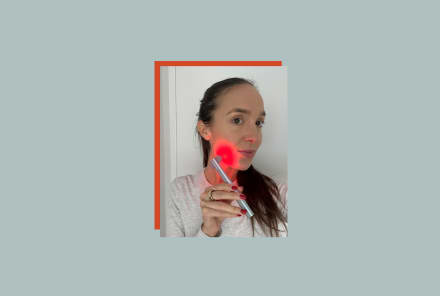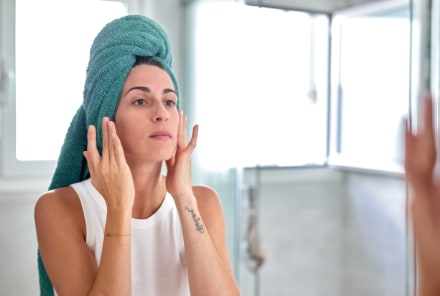Advertisement
I Tried Shaving My Face For Better Skin: Here's What Happened

After reporting on the face-shaving trend, I decided to test whether taking a razor to my countenance would reap the benefits they (skin care maven Kate Somerville and celebrities Marilyn Monroe and Elizabeth Taylor are among its proponents) claim: brighter, softer, even-textured skin thanks to increased exfoliation and better product penetration. Bonus? Smoother skin also allows foundation to look more natural.
Let's be clear: I was afraid to shave my face.
Especially after talking to holistic makeup artist Katey Denno about her experience. Many of her clients who are models swear by it, but shaving didn't work for Denno. "I created a group of ingrowns and whiteheads that ravaged the skin around my chin that took me almost six months to repair," she told me over the phone. It's true—shaving isn't for everyone. I did a patch test before embarking on this three-week journey on one of my "sideburn" areas, and I recommend anyone trying it for the first time do the same. After a few days of testing, the coast was clear.
A small part of my fear stemmed from the idea that hair would grow back darker and thicker, but Denno assured me that is just a myth. "The hair may feel a little stubbly for a few days, but that's because our natural hair is tapered. When we cut it, it's the blunt end that grows and gets longer, which makes the hair feel more soft." But I was afraid of cutting my face, my hands, or worse: causing a breakout that lasted six months.
I felt the fear and did it anyway. Here's what happened.
I used the Tinkle razor, which is designed for eyebrows, but thanks to the internet, I learned how to use it on the face. Mastering the stroke technique was tricky, especially around contoured areas like the nose, chin, and eyebrows—I watched quite a few YouTube videos on the topic and slowly developed my own technique. After trying it without an oil on my patch test, though, I decided to use a squalane oil to prevent itchiness and stop the irritation I was experiencing.
After figuring out how to reduce redness, I loved it. The act of shaving felt oddly masculine, which was interesting because I ultimately felt rejuvenated and more like myself afterward. As someone who doesn't get facial hair waxed or shaved regularly, I didn't know what to expect. And yes: Skin care seems to work better, and foundation goes on more smoothly.
It did start to feel "stubbly" when it was growing in initially, but after waiting a few more days it was essentially back to "normal." I shaved twice more and kept it up for three whole weeks. The only downside? Time. I wish it didn't take as long as it did to get a good shave.
Learn from my mistakes.
If I could go back in time, this is what I'd tell myself and what I wish I'd known before I started:
1. Do a test patch first.
I have sensitive skin, so this is always a must before trying anything new, but this is a must for all skin types especially when it comes to using a razor. You never know how your skin will react.
2. Take your time.
Shaving will probably take between five and 10 minutes—in the scheme of things, that's not too bad. Don't risk cutting your precious mug. Safety first!
3. Use an oil if your skin is sensitive.
Just as you might use an oil or shaving cream on your legs and underarms, it's a good idea (especially for sensitive skin) to create a buffer between your skin and the razor. It will help with redness.
4. Use short downward motions.
Do not go against the grain. I repeat: Do not go against the way the hair grows. This will cause immediate redness and ingrown hairs later on. Instead, go with the hair follicle and hold your Tinkle razor at about a 45-degree angle to your face, razor pointing down.
5. You probably don't need to shave your whole face.
Your forehead, for example, is probably not that hairy. You certainly don't have to shave your entire face—instead, focus on the areas with the most growth.
6. Don't shave if you have an active breakout.
Shaving over acne or an open wound will only aggravate it and can potentially cause infection. Safety first, always!
7. Sanitize your razor.
I don't like using these razors more than a few times—directly after using them, I let it sit in a glass of rubbing alcohol for a few minutes and then I rinse. I do the same when I pick it back up to shave again.
While I'm not sure I'll do this once a week, I will absolutely do it before events or whenever I need to be on-camera. The skin simply looks better. Of course, this is what worked for me—if you have any concerns or questions, discuss with a professional or your derm.
Want to exfoliate your skin without a razor for now? Try one of this year's best gentle exfoliants.
Watch Next
Enjoy some of our favorite clips from classes
Enjoy some of our favorite clips from classes
What Is Meditation?
Mindfulness/Spirituality | Light Watkins
Box Breathing
Mindfulness/Spirituality | Gwen Dittmar
What Breathwork Can Address
Mindfulness/Spirituality | Gwen Dittmar
The 8 Limbs of Yoga - What is Asana?
Yoga | Caley Alyssa
Two Standing Postures to Open Up Tight Hips
Yoga | Caley Alyssa
How Plants Can Optimize Athletic Performance
Nutrition | Rich Roll
What to Eat Before a Workout
Nutrition | Rich Roll
How Ayurveda Helps Us Navigate Modern Life
Nutrition | Sahara Rose
Messages About Love & Relationships
Love & Relationships | Esther Perel
Love Languages
Love & Relationships | Esther Perel

















